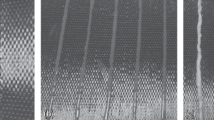The results of studies of the physical and mechanical properties of glass fiber reinforced plastics [GFRP] modified by carbon nanotubes are reported. An epoxy binder was chosen as the polymer matrix; the glass fibers were macroscopic filler. Multilayer carbon nanotubes were used as the modifying additive. The mechanical properties of the polymer composites were analyzed as a function of the geometric parameters of the carbon nanotubes.


Similar content being viewed by others
References
S. N. Grigoriev, A. N. Krasnovskii, and I. A. Kazakov, “Effect of preliminary heating of the binder on the quality of glass composite pultrusion rods,” Steklo Keram., No. 8, 36 – 40 (2015); S. N. Grigoriev, A. N. Krasnovskii, and I. A. Kazakov, “Effect of preliminary heating of the binder on the quality of glass composite pultrusion rods,” Glass Ceram., 72(7 – 8), 299 – 302 (2015); DOI: 10.1007_s10717-015-9778-3.
I. A. Kazakov and A. N. Krasnovskii, “Effect of functionalized multiwalled carbon nanotubes on the feasibility of fabrication of composite glass fiber reinforced plastic rebars,” Zh. Prikl. Khim., 89(8), 1062 – 1070 (2016); I. A. Kazakov and A. N. Krasnovskii, “Effect of functionalized multiwalled carbon nanotubes on the feasibility of fabrication of composite glass fiber reinforced plastic rebars,” Russian J. Appl. Chem., 89(8), 1309 – 1316 (2016).
I. A. Kazakov, A. N. Krasnovskii, and A. G. Kuznetsov, “The use of optimization algorithm for assessing effects of Carboxyl functionalized MWCNTs on the productivity of nidltrusion process,” J. Nanostruct., 7(2), 89 – 96 (2017); DOI: 10.22052_jns.2017.02.001.
A. N. Krasnovskii, P. S. Kishchuk, and T. M. Mukhin, “Study of the quality of carbon nanotubes produced by chemical vapor deposition,” Zh. Prikl Khim., 90(5), 1230 – 1233 (2017); A. N. Krasnovskii, P. S. Kishchuk, and T. M. Mukhin, “Study of the quality of carbon nanotubes produced by chemical vapor deposition,” Russian J. Appl. Chem., 90(9), 1484 – 1487 (2017); DOI: 10.1134_S1070427217090178.
N. Stepanishchev, “Nanocomposites: Problems of filling,” Plastiks, No. 4 (86), 23 – 27 (2010).
V. A. Tarasov and N. A. Stepanishchev, “Application of nanotechnologies for hardening the polyester matrix,” Vest. MGTU Im. N. E. Baumana, Ser. Mashinostroenie, Spec. issue, 207 – 216 (2010).
J. C. Halpin and J. L. Kardos, “The Halpin–Tsai equations: a review,” Polym. Eng. Sci., 16(5), 344 – 352 (1976).
J. N. Coleman, U. Khan, W. J. Blau, and Y. K. Gun’ko, “Small but strong: A review of the mechanical properties of carbon nanotube-polymer composites,” Carbon, 44, 1624 – 1652 (2006).
C. A. Cooper, S. R. Cohen, A. H. Barber, and H. D. Wagner, “Detachment of nanotubes from a polymer matrix,” Appl. Phys. Lett., 81, 3873 – 3875 (2002).
Kenan Song, Yiying Zhang, Jiangsha Meng, et al., “Structural polymer-based carbon nanotube composite fibers: Understanding the processing–structure–performance relationship,” Materials, 6(6), 2543 – 2577 (2013).
Author information
Authors and Affiliations
Corresponding author
Additional information
Translated from Steklo i Keramika, No. 5, pp. 8 – 11,May, 2019.
Rights and permissions
About this article
Cite this article
Krasnovskii, A.N., Kazakov, I.A. & Kishchuk, P.S. Mechanical Properties of Glass Fiber Reinforced Plastics Modified with Carbon Nanotubes. Glass Ceram 76, 167–170 (2019). https://doi.org/10.1007/s10717-019-00173-8
Published:
Issue Date:
DOI: https://doi.org/10.1007/s10717-019-00173-8




